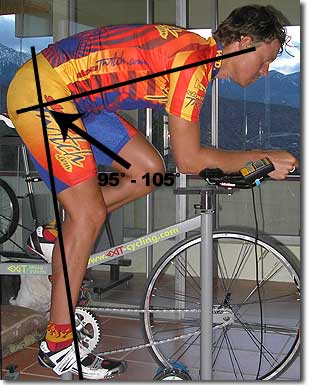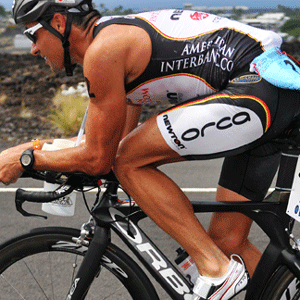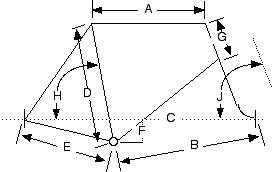Hip angle
You'll want to follow the articles in succession, starting with Intro to the F.I.S.T. Method:
1. F.I.S.T. axioms
2. F.I.S.T. protocol
3. Measuring conventions
4. Seat height
5. Cockpit length
6. Hip angle <– You are here
7. Armrest drop
8. Tools of the trade
9. Your bike's "waistline"
10. Translating fit specs to bike specs
If you're following this as a progression, you should've read our article on Cockpit length prior to this. Our series begins here.
At this point in a fit there's just one major parameter left to consider, and that's how high or low the aero bars are relative to the saddle. This determines your hip angle.
As with every other element of the fit, under normal circumstances the most precise measuring instrument is the human body itself. A person knows when he's able to comfortably push greater power or not, and pitting heart rate and power against various hip angles certainly may work. But this method is cumbersome, often leads to bad conclusions, and ultimately not as accurate as simply placing trust in a person's own subjective notion of what's at once powerful and comfortable.
This being the case, I simply drop the front of the bike about a centimeter at a time, asking the subject if that's "better, worse or the same." Only if it's "worse" do I stop the exercise.
The position simulator I use for this allows me to lower the front of the bike while the subject is riding. This is helpful, because the instant feedback provided makes it easy for the subject to know when the front has been lowered to a point that's just too low.
When the subect cries "uncle," I then revert to a new method. I raise the bars 2cm, and ask the subject to select between two options, this one versus 1cm lower (the last place the subject considered acceptable). If the subject chooses the higher option, I go through the process yet again, raising the handlebar 2cm. It's usual for the subject to be much more equivocal with the bars "on the way up," versus "on the way down." It's easier to "feel" what's better versus worse.
Once the subject selects the desired aero bar elevation, he has by definition selected his desired hip angle. In almost all cases, there's a pretty narrow range he'll self-select, and that's a hip angle of 95° to 105°. You might think range of motion is an issue here. Almost never is this the case, because a nexus of power is reached before reaching the limit of one's range of motion. A hip angle of 100° is almost always achievable by just about everyone suited for tri bike riding.

Whether riding at 76, 78 or 80 degrees, it's typical to find a subject choosing the exact hip angle at each successive seat angle. It ought to become apparent, in this case, that a very specific and narrow range exists for the placement of this subject's aero bars, and in each case it's related to his hip angle. In other words, he doesn't have a specific amount of "armrest drop" in elevation relative to his saddle. It changes depending on his seat angle. The constant is his hip angle. That's what he'll seek to preserve as he's rotated around the bottom bracket as if around the face of a clock. He certainly may exhibit a preference for one specific place around this clock — that is, he'll prefer one specific seat angle — but his preference for armrest elevation is going to change based in the seat angle in which he's placed. The angle of his hip while in the aero position is the critical element.
To measure this hip angle, again we visit the greater trochanter, and this is our hip angle's fulcrum. We draw a line through to the clavicle, and another through the bottom bracket. I typically have the subject lower his drive side leg to bottom-dead- center (if I'm working on the drive side), but he can be wherever around the pedal stroke he wants, since you're measuring to the BB.
Now, it's certainly true that there are other places one could choose as measuring points. One could choose to measure down the femur (through the knee), instead of through the bottom bracket. In this case, of course, the placement of the foot at BDC is required. One could also choose to measure the acute hip angle, through the knee at top-dead-center. I have no problem with either of these methods. Of course, this would require a different set of ranges. Perhaps the acute angle of the hip, at TDC, ought to be 25 degrees, instead of "my" 100 degees at BDC. Any of that is fine, though the acceptable ranges will change.
In all these cases, the rider's armrest elevation relative to the saddle, at each given seat angle, is going to be the same. Simply put, other systems, with other reference points, can work fine with this proviso: Subjects will keep self-selecting hip angles that are within a narrow band. Any good system will honor this. Any system with ranges that do not comform to subjects' self-selected norms is, well, not good.






Start the discussion at forum.slowtwitch.com